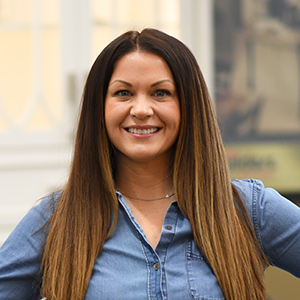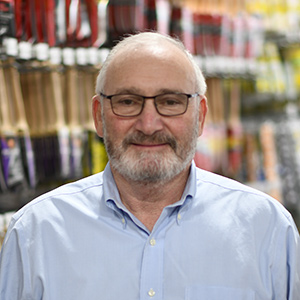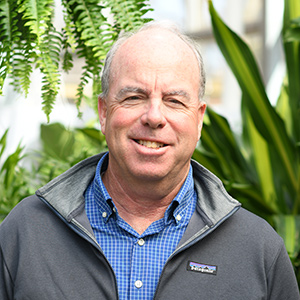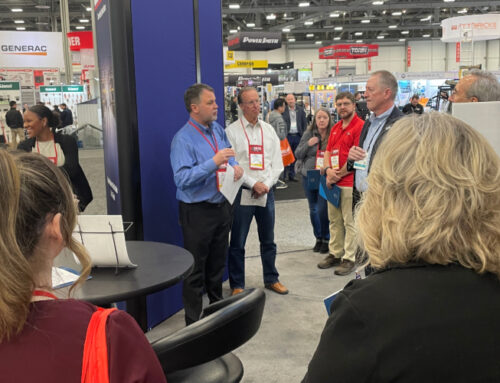For 16 years, the North American Hardware and Paint Association (NHPA) has recognized key home improvement operators for their successes and strategic innovations with the Top Guns Award. This award highlights innovative retailers who are setting their operations up for growth and success for generations to come.
On the following pages, meet this year’s honorees, three retailers who represent distinct operations, and who are all committed to making the independent channel a place where people want to work and want to shop. Learn about their strategies for finding and keeping key talent, their plans for investing in their companies after record-breaking years and how they see independents competing in the channel and the industry.
For more, listen to the Top Guns episode of the “Taking Care of Business” podcast and see inside their operations here.
 Stacy Bivona
Stacy Bivona
In 1977, Myron Andersen started Builders, and in its first year, the company did $155,000 in sales. Today, Builders serves contractors and home builders from coast to coast from its retail lumberyards, design centers, installed sales services and truss manufacturing and countertop fabrication operations in Nebraska and Colorado.
Stacy Bivona is Andersen’s daughter and current vice president of Nebraska operations and marketing for Builders. She says her parents always encouraged her and her brother, Chad, to explore their passions.
“Chad and I both went to college, and our parents made it very clear that we should do whatever made us happy,” Stacy says. “It was never a requirement that we come into the family business.”
After college, Chad pursued construction, and he eventually returned to Builders to help launch and lead operations in Colorado.
Stacy earned degrees in design and marketing, and after graduating, she joined a fashion clothing company headquartered in Kearney, Nebraska, working as a women’s apparel buyer and in product development.
“I had quite the learning experience with that company,” Stacy says. “I learned about the buying process, negotiating with vendors, company culture and working with management in a corporate environment. I’ve always been drawn to fashion and pretty things, whether apparel or home design, so it came naturally to me.”
Stacy utilized the comprehensive services offered through Builders when she was building her first home, and she realized how much her passion overlapped with the family business.
“It was very exciting to see that process from the beginning to the final completion of the house. That’s where I found my love for it,” she says. “Then, around the dinner table with my family, my dad said if I was considering working in the business, we needed to have a serious conversation about it.”
Stacy came to Builders in 2009, and she had to prove she could contribute.
“While I eventually grew into a marketing role, I had to really earn it,” she says. “I worked on the floor, I worked in the design center, and in the cabinetry and countertop areas, and I worked with customers. Since I had a background in buying and marketing, I also worked on our vendor relationships and purchasing.”
Service at the Core
As the landscape in the industry has changed, so has Builders to respond to the needs of its core customer base: contractors and home builders. Stacy has been a key part of the company’s growth over the last decade, relying on Builders’ loyal customer base and growing into new markets based on their requests and suggestions.
“From Day 1, we’ve been focused on providing top-tier customer service, and it’s because we talk to our customers to find out what their challenges are and what they want from us,” Stacy says. “We’re honest and we walk them through a project, whether they’re a professional or a DIYer. We’ve spent decades forging strong relationships with our vendors, which has helped us earn the reputation of being able to source just about anything.”
Comprehensive customer service is a key part of the complete building solutions customers find when they walk into Builders. The Kearney location features 67,000 square feet of salesfloor, warehouse and design center space, and it also has a separate drive-through lumberyard. There is the main entrance for retail customers, as well as a separate entrance and grab-and-go area of the salesfloor that Builders’ professional contractor customers use for quick trips to grab a few boxes of nails or caulk.
“We have such fantastic relationships with our contractors here,” Stacy says. “We’ve been here for 45 years, so they rely on us and know what we are able to provide.”
And provide Builders does. Because of the company’s extensive manufacturing, fabrication and installation segments, Builders can provide everything someone needs for a new build or renovation project. To bolster this service, the Kearney location is currently undergoing a renovation of its design services center. When it’s complete, customers will have a separate entrance and spaces to meet with designers.
In addition to having established relationships with contractors, interior designers and consultants also rely on Builders. In the new space, independent consultants will have dedicated meeting rooms to meet with clients and show them the possibilities Builders has to offer. This renovation isn’t the last project the company has planned.
“We’re creating a replicable model to put in our other markets,” Stacy says. “We’re already looking for acquisition opportunities, and we have growth plans for the Colorado market and new markets and segments on the horizon.”
Stacy says a key department is paint because so many projects start there.
“Any project someone is going to be doing on their home, paint is going to be involved,” Stacy says. “We like to focus on paint as the starting point to learn the scope of their project and capture the whole thing. If someone comes here to choose paint for their kitchen, it’s a great entry to talk about tile or flooring or appliances.”
Staff at Builders is more than a group of employees, Stacy says; they’re family. And each person on the team has a responsibility to deliver the high level of service that Builders has earned a reputation for over the last 45 years.
“We believe so deeply in the people who work for us. If we didn’t have this team, we wouldn’t have a business. It’s very important for us to continue to invest in our team and seek information,” Stacy says. “For example, our drivers who are out delivering materials are the last people to interact with our customers, so we empower them to seek feedback and continue that thread of high-quality service all the way until the end.”
Investing in the team is a key focus for the company for the foreseeable future, Stacy says, whether that’s offering additional training or creating opportunities for leadership development.
“With the labor market the way it is, we’ve been recruiting, but it’s certainly been challenging. Our current team has been flexible, and they’ve all been willing to do jobs that are maybe outside their scope of responsibilities to keep things running,” she says. “Our culture here is very family-oriented. We encourage open conversations to find out what their passions are so we can put them on the right career path.”
With growth in the forecast, another space Builders is investing in is e-commerce and the company’s digital presence. The company website is undergoing a facelift that will better serve the needs of all the company’s customers, which shifted during the pandemic.
“Just like for the majority of the industry, our retail sales have picked up over the last few years as people were investing in their homes,” Stacy says. “To retain those customers, we need to be sure our online presence meets their needs.”
The website overhaul will feature different segments for each business division so each audience can better access the information they need.
“Our vision is that it will be for both retail and contractor audiences. The platform is about convenience,” Stacy says. “Contractors will be able to order online, and we’ll have options for delivery and pickup, and the retail customers will be able to access our full catalog of products so they can see everything we have to offer.”
Having the opportunity to make continued strategic investments in Builders and its people is something Stacy says she’s grateful to be able to be a part of.
“We are a servant-based company. That is our mission. We want our team, our family members and all of our customers to be very proud of the work we do collectively,” she says. “We’re excited to exist in this space. Not a day goes by that we aren’t counting our blessings.”
 Elliot Greenberg
Elliot Greenberg
JC Licht was founded by the Licht family in Chicago in 1907, growing to dozens of locations over nearly the next century until 2000 when Benjamin Moore purchased the operation. A little over a decade later, the paint manufacturer decided to exit the retail business and sought a buyer for JC Licht, which at that time boasted 29 locations.
Elliot Greenberg had spent over 30 years in the independent paint business, and at the time, he served as vice president of sales, operations and marketing for Ring’s End, a comprehensive home improvement business in Connecticut. Prior to that, he had spent 15 years in his family’s paint business, running a busy store serving contractors in New Jersey.
“I remember delivering paint to contractors with my mom in her station wagon when I was four years old and getting 10 cent tips. It was in my blood,” he says. “It was always something I cared for and loved, but it wasn’t always a goal for me. I thought I would go to law school or become a sports agent.”
The job at Ring’s End—helping the company start up its paint operations—was an opportunity Elliot couldn’t pass up. Elliot says his time there was a crucial part of his development as a leader and a businessman.
“I wanted to prove myself beyond the family. At Ring’s End, I had to learn from scratch how to do what I did,” he says. “I was treated really well, and I learned so much. The owners gave me a lot of leeway to grow the business and we grew dramatically in every aspect. It was probably the greatest 20 years I’ve had in the business.”
Elliot spent time cultivating a relationship with Benjamin Moore during his time at Ring’s End, which is how he learned of the opportunity to buy JC Licht in 2014.
After spending two decades learning how to run a comprehensive operation, he saw the potential in JC Licht, and officially became the owner in January 2015. Over the last seven years, Elliot has put the company on an aggressive growth path, and he has focused on establishing a leadership team that is dedicated to the company’s core values.
“I look at this operation as an extension of Ring’s End. I was very experienced as an executive only because of my time there,” he says. “I learned a lot about core values there, and that helped inform so much of what we do here today at JC Licht.”
People at the Core
In every one of the company’s 57 locations, the core values of JC Licht adorn the walls wherever employees gather and they guide every decision. As the company has grown, Elliot’s leadership team has played a key role in communicating the core values, ensuring each team member knows they are critical to JC Licht’s success.
Early on in his tenure, Elliot attended a CEO conference where he was introduced to the book “Traction” by Gino Wickman. The lessons he learned from the book, and the Entrepreneurial Operating System® (EOS) it introduces, have been an integral part of his strategy since.
“‘Traction’ helped us transition from a highly entrepreneurial company to a growth-oriented business,” Elliot says. “It encompasses how we operate our company on a weekly, quarterly and long-range basis, informing our three-, five-, and ten-year plans.”
Lessons from the book led the JC Licht leadership team to develop the company’s core values based on the characteristics of high-performing employees.
“Kim [Smuda], our senior office administrator, was the first person we named. She had it all,” Elliot says. “We continued naming other people with the traits we thought would take us to the next level. Looking back on that process, I wouldn’t change anything.”
With the core values established, the leadership team got to work further developing the culture of the business. Elliot says the biggest challenge for the staff was learning how to say yes.
“The people I inherited were afraid to say yes, and we had to change that dynamic,” Elliot says. “I met with all of our big customers, listening to them and learning their challenges. They quickly understood that I care about them, and I will come up with solutions.”
Elliot says the company’s flexibility as an independent business is a key part of how they can compete against national brands.
“I can make decisions on the spot, where national chains are limited,” he says. “We taught our people that they also have the authority to make those quick decisions. So we came up with a slogan: Make it happen.”
The “make it happen” philosophy is now a common sight throughout all JC Licht operations, seen on the back of company t-shirts and on shopping bags so every customer knows there is a solution available if they ask.
This strategy also paid off over the last two years as JC Licht staff adapted to changing customer demographics—and their vastly different needs—during the course of the pandemic.
JC Licht has had a strong contingent of DIY and retail customers, but its primary customer base is about 70 percent contractor. The communication style needed for these two groups is completely different, and leadership identified an opportunity for improvement when homeowners started calling the stores for advice.
“When a homeowner calls and they start with, ‘I just have a quick question,’ I know that means it’s not quick,” Elliot says. “They need more dedicated guidance.”
The company developed a training program called Phone Excellence to address the different communication needs of retail customers. Every Tuesday, a communication consultant trains new staff members on how to answer the phone. Every associate is required to complete 16 hours of phone training to prepare them to serve any customer.
“The training has been game-changing, and it’s a great opportunity to grow our retail business,” Elliot says. “At the end of the day, we’re accomplishing our goal of treating all customers with the same love, attention and focus, and I think our people are doing a great job.”
Growth Plans
In addition to investing in people over the last seven years, JC Licht has been investing in store development and growth in new areas. When Elliot took ownership, the business had 29 stores. Today, the company is 57 locations strong, including entering a new state and foraying into hardware.
“I don’t have a goal of a certain number of stores by a certain time, but we evaluate our markets every three months,” Elliot says. “I think we have the pillars that we need to go forever. Individual paint stores, both commercial and industrial; wood coatings; home fashions, including wallcoverings and window treatments; and more JC Licht Ace stores. These are the things we know and do well.”
The company’s next step is further expansion into Wisconsin and entering the Indiana market. The growth strategy is as much about growing the brand as it is about creating job opportunities.
“We have about 575 associates, who we call family members,” Elliot says. “Especially during COVID, we’ve seen a lot of new people come from other jobs for better pay and more opportunities. They know we’re a growing company, and they can see all the pathways they have.”
JC Licht has a generous employee referral program that has led to strong recommendations. Employees receive $750 for each referral they make, and Elliot says that investment is worth it.
“It works. We’re getting high-quality people from referrals,” he says. “Because we’ve grown so much, we have 70 to 80 people who are somehow related to another employee.”
Elliot says he is energized by the opportunities that are around every corner, and he’s grateful for the opportunity to lead an organization like JC Licht.
“I wake up every morning, and I get excited,” he says. “I thank God every day for how lucky I am to be in such a great industry.”
 Pat Sullivan
Pat Sullivan
Sullivan Hardware & Garden has been a part of the Indianapolis independent home improvement market for nearly 70 years. Robert Sullivan founded a small hardware store in 1954, and then in 1963, the business moved to its flagship location where the company’s core business still operates today.
One of seven children, Pat Sullivan says it was always his plan to take over. In 1989, at 29 years old, he bought the business from his father, who retired the following year. Over the last 30 years, Pat has made strategic investments in Sullivan Hardware & Garden. The business is not only a reliable place for people to buy core hardware needs, but it is a true destination for people throughout the state year-round.
“When I first took over from my father, I thought what we were doing would last forever,” he says. “We had some regional competition, but we always gave good service. Then when big-box stores came to town in the early 2000s—one within a mile of our flagship—we lost contractor business and some other bigger ticket business. We had to evolve.”
Pat says while they retained a core group of loyal customers, he wanted the store to be more than just a convenience hardware store.
“I want people to be excited about coming to our store,” he says.
Pat’s strategy to differentiate his operation came down to five product segments that he knew they could do better than the big-box stores: Green goods, fireplaces, mid-price patio furniture, grills and artificial Christmas trees.
“We failed at fireplaces,” Pat says. “I always tell that part of the story because it’s important for other retailers to know that not everything works out. But we’ve become the place to go for those products.”
Sullivan Hardware & Garden features four different locations, and all of them are distinct, which Pat says complicates marketing to a certain extent, but each business serves the immediate needs of the local communities.
The flagship store now occupies 5 acres and features a greenhouse and outdoor space, a full-service restaurant and a separate gift shop in addition to the core hardware store. The other locations include a smaller hardware store in a historic neighborhood less than 5 miles away, and another hardware store about 40 miles north of Indianapolis that serves a town of just over 4,800 residents with a core hardlines store and a live goods space. The most recent addition to the Sullivan family of stores is a garden center Pat purchased in early 2020.
“I wasn’t necessarily looking at adding another location, but this garden center is a wonderful, 44-year-old business,” Pat says. “The owner was ready to retire, and I saw the potential there.”
He has invested about $3 million to make it consistent with the other locations, including adding 10,000 square feet of salesfloor space and opening another restaurant. The business previously only sold live goods, so now it features grills and a complete lawn and garden hard goods department.
“Instead of people going for plants and live goods and then going to a box store to get all the tools they need, they’re staying in that store,” Pat says.
Entertainment Central
In addition to identifying the core product areas that would help the business stand out in a crowded market, Pat’s strategy to bring customers to the stores has been all about entertainment.
The flagship store is known throughout the state as the place to go during the holiday season. The company’s focus on artificial Christmas tree sales is a standout; the business sells more than 150 different styles of trees, and in 2021, sales totaled over $800,000. To further support the category, the company offers a unique service: Christmas tree storage. For $30 per foot, area residents can store their trees during the off-season in the warehouse, and then when they are ready, a team will deliver it and set it up. Hundreds of customers utilize the service, and Pat says it also keeps the warehouse staff busy during slower times of the year.
Christmas trees are just the tip of the holiday season iceberg at Sullivan’s. In fact, one attraction alone brings more than 50,000 visitors through the store from early November through Christmas Eve. The Sullivan Express is a holiday-themed train that takes children of all ages on a tour of the North Pole—an extravagantly decorated greenhouse—to meet Santa Claus. Demand is so strong that ticket sales are timed. They go on sale on the Sullivan Hardware website at precisely 4 p.m. on Nov 1. Last year, 1,700 tickets were sold in the first 3 minutes.
At the new garden center, a similar event is taking shape in celebration of Halloween, with Sullivan Express to Pumpkintown quickly becoming a tradition.
The restaurant is another unexpected draw that Pat says developed out of the company’s focus on another seasonal product: grills. To become a destination for grills, first, the business stocked dozens of different grills and price points. Second, they established a commercial kitchen to host grilling classes. The kitchen became an attraction throughout the year for classes and when it was open during the Sullivan Express season.
Pat and his staff noticed that people would come to the store specifically to get food from the kitchen because they had loved it so much during the holidays, only to see it wasn’t open.
“Customers could get a sandwich, a glass of wine during Christmas, and then they would come back in the spring, maybe for plants, and they would be disappointed because it was closed,” Pat says. “So we realized, on one hand, we were telling everyone how cool we were and then we disappointed them. We realized we needed to be in the full-service restaurant business, so we’re open from lunch until dinner six days a week.”
Today, the restaurant and garden center also serve as a place for private parties, like wedding and baby showers, and even celebrations of life for beloved customers.
Core Communication
Pat admits the business isn’t as strong as it should be in regard to e-commerce, but he says that side of retail is crowded, and it’s harder to compete. Instead, the Sullivan Hardware & Garden digital team focuses on transitioning the entertainment at the store to social media, where it’s easier to communicate with customers and lean into word-of-mouth marketing. The business currently has over 6,000 followers on Instagram and more than double that on Facebook.
“It’s harder for us to push out our products for sale because everyone does that,” Pat says. “But on the social media side, we’re showing off Slawfest, our annual celebration of coleslaw. That’s a lot easier for us to market than getting someone to buy a grill from us.”
Showing off the fun side of hardware retailing is part of Pat’s core strategy, and he says all hardware store operators should make their stores a destination.
“No matter how small you are, you need to be a fun place to shop,” he says. “As hardware stores, we have all hung our hat on good service, but everyone expects good service. So if you start there, you’re at zero, so now what do you have?”
There aren’t immediate plans to grow the footprint of Sullivan Hardware & Garden further, but Pat says the future is about continuing to enjoy the company’s niche business and treading the line between hardware, garden center and something else completely.
“People ask, ‘What are you?’ I always say the hardware industry doesn’t want to claim us, and the garden center industry doesn’t want to claim us, so we’re just kind of floating in the middle,” he says. “We make people in their daily lives stop and say ‘Let’s go there,’ when maybe they don’t even have a reason to.”


 Stacy Bivona
Stacy Bivona Elliot Greenberg
Elliot Greenberg Pat Sullivan
Pat Sullivan



